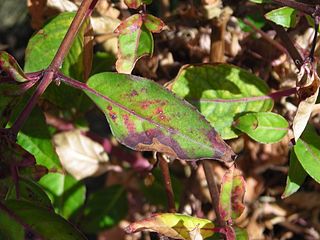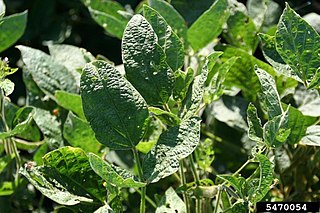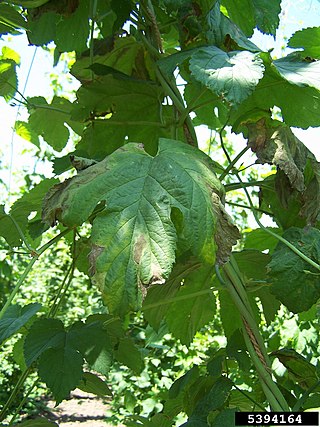Peach latent mosaic viroid is a species of the genus Pelamoviroid, which belongs to the family Avsunviroidae. This family is characterized as having chloroplastic viroids with hammerhead ribozymes. Peach latent mosaic viroid is a 336-351nt circular RNA which has a branched formation. This branched formation is stabilised by a pseudoknot between two kissing loops. Peach latent mosaic viroid was first described in the 1980s in Spain by a group of scientists.

Pseudomonas cannabina is a gray, Gram-negative, fluorescent, motile, flagellated, aerobic bacterium that causes leaf and stem rot of hemp, from which it derives its name. It was formerly classified as a pathovar of Pseudomonas syringae, but following ribotypical analysis, it was reinstated as a species. The type strain is CFBP 2341.
Alternaria japonica is a fungal plant pathogen. It is a cause of black spot disease in cruciferous plants. It is not a major source of crop loss, but is considered dangerous for plants during the seedling stage.
Stemphylium globuliferum is a plant pathogen infecting alfalfa.
Pseudocercospora cannabina is a fungal plant pathogen infecting hemp. Cercospora cannabina was originally found on the leaves of Cannabis sativa in Uganda. Then in 1976, it was renamed as Pseudocercospora cannabina by mycologist Frederick Claude Deighton (1903-1992).

Neocosmospora vasinfecta is a fungal plant pathogen that causes, among other types of infections soybean stem rot.
Pythium dissotocum is a plant pathogen infecting strawberry and rice.

Beet curly top virus (BCTV) is a pathogenic plant virus of the family Geminiviridae, containing a single-stranded DNA. The family Geminiviridae consists of nine genera based on their host range, virus genome structure, and type of insect vector. BCTV is a Curtovirus affecting hundreds of plants. The only known vector is the beet leafhopper, which is native to the Western United States.
Cherry mottle leaf virus (CMLV) is a plant pathogenic virus causing leaf rot. It is closely related to the peach mosaic virus.

Impatiens necrotic spot orthotospovirus(INSV) is a plant pathogenic virus of the order Bunyavirales. It was originally believed to be another strain of Tomato spotted wilt virus, but genetic investigations revealed them to be separate viruses. It is a negative-strand RNA virus which has a tripartite genome. It is largely spread by the insect vector of the western flower thrips. The virus infects more than 648 species of plants including important horticultural and agricultural species such as fuchsia, tomato, orchids, and lettuce (especially romaine). As the name implies, the main symptom on plants is necrotic spots that appear on the leaves. The INSV virus infects by injecting the RNA the virus contains into the cell which then starts using the cell resources to transcribe what the virus RNA states. Viral infection can often result in the death of the plant. The disease is mainly controlled by the elimination of the western flower thrip vector and by destroying any infected plant material.

Soybean mosaic virus (SMV) is a member of the plant virus genus Potyvirus. It infects mainly plants belonging to the family Fabaceae but has also been found infecting other economically important crops. SMV is the cause of soybean mosaic disease that occurs in all the soybean production areas of the world. Soybean is one of the most important sources of edible oil and proteins and pathogenic infections are responsible for annual yield losses of about $4 billion in the United States. Among these pathogens, SMV is the most important and prevalent viral pathogen in soybean production worldwide. It causes yield reductions of about 8% to 35%, but losses as high as 94% have been reported.

Puccinia thaliae is the causal agent of canna rust, a fungal disease of Canna. Symptoms include yellow to tan spots on the plant's leaves and stems. Initial disease symptoms will result in scattered sori, eventually covering the entirety of the leaf with coalescing postulates. Both leaf surfaces, although more predominant on the underside (abaxial) of the leaf, will show yellow to brownish spore-producing these pustulate structures, and these are the signs of the disease. Spots on the upper leaf-surface coalesce and turn to brown-to-black as the disease progresses. Infection spots will become necrotic with time, with small holes developing in older leaves. These infected leaves eventually become dry and prematurely fall.
The hop stunt viroid is a viroid species that infects the common hop plant, citrus plants, grapevines, cucumber, and several Prunus species such as almond, apricot, plum, and peach. It is asymptomatic or latent in most host plants, but in some hosts it can cause stunting and other symphtoms. A study of HSVd-infected hops in the USA showed that the severity of yield reduction was highly dependent on the infected hop cultivar.
High plains disease is a viral disease afflicting wheat and maize. It is caused by the negative-sense ssRNA virus High Plains wheat mosaic emaravirus. Symptoms are similar to Wheat streak mosaic virus, with leaf veins showing yellow flecks and streaks, followed by leaf margin purpling in maize. Depending on the timing of infection, stunting and death occur. Plants can be doubly infected with high plains virus and wheat streak mosaic virus.

Verticillium nonalfalfae is a soilborne fungus in the order Hypocreales. It causes verticillium wilt in some plant species, particularly Ailanthus altissima. The fungus produces a resting mycelium characterized by brown-pigmented hyphae. It is most closely related to V. dahliae and V. alfalfae.
Papaya leaf curl virus(PaLCuV) is a DNA virus from the genus Begomovirus and the family Geminiviridae. PaLCuV causes severe disease in papaya (Carica papaya), but can sometimes infect other crops such as tobacco or tomato. It can be found in tropical and subtropical regions primarily in India, but closely related species have also been detected in countries such as China, Malaysia, Nigeria and South Korea. This virus is transmitted by an insect vector from the family Aleyrodidae and order Hemiptera, the whitefly Bemisia tabaci. PaLCuV has been responsible for several epidemics and causes severe economic losses. Because of the broad diversity of these viruses, their characterization and control remains difficult.
Cranberry fruit rot (CFR) is a disease complex of multiple fungal agents affecting the American cranberry. Cranberry fruit rot can be categorized into field rot and storage rot. The importance of field rot and fruit rot depends on how the cranberries will be processed after harvest. If cranberries are immediately processed after harvest, growers focus on preventing field rot while with fresh market cranberries, growers seek to prevent storage rot. There are 10-15 fungal pathogens known to cause cranberry fruit rot diseases, some active in only field rot, storage rot, or both. The majority of these fungal pathogens are ascomycetes, with the rest being deuteromycetes. There is no known bacterial pathogen that plays a role in CFR or any major disease on cranberry, potentially due to the low pH conditions on the cranberry fruit.

Tomato brown rugose fruit virus (ToBRFV) is a plant virus in the genus Tobamovirus that was first described in 2015. It has spread rapidly since it was first noted in Jordan and Israel. The main hosts are tomato and peppers. The virus causes symptoms including mosaic and distortion of leaves and brown, wrinkly spots (rugose) on fruits. Outbreaks can be severe and leave fruit unmarketable.

Colletotrichum fioriniae is a fungal plant pathogen and endophyte of fruits and foliage of many broadleaved plants worldwide. It causes diseases on agriculturally important crops, including anthracnose of strawberry, ripe rot of grapes, bitter rot of apple, anthracnose of peach, and anthracnose of blueberry. Its ecological role in the natural environment is less well understood, other than it is a common leaf endophyte of many temperate trees and shrubs and in some cases may function as an entomopathogen.
Epicoccum sorghinum is an ascomycete fungus with known plant pathogenicity to sugarcane and rice, causing ring spot disease and leaf spot disease. This fungus is primarily known for its production of tenuazonic acid, which leads to complications with growth and causes the symptoms of leaf spot disease. Tenuazonic acid not only affects plant growth, but has recently been proven to impact human health due to its prevalence in food and beverages. It is widely dispersed, affecting multiple hosts in different countries. Although not a serious threat, Epicoccum sorghinum has been known to influence the sorghum grain-mold complex in ways which reduce crop yields, seed viability, and kernel weight. As a result of continuous phylogenetic and morphological discoveries relevant to Epicoccum sorghinum, this fungus has undergone a number of name changes.








